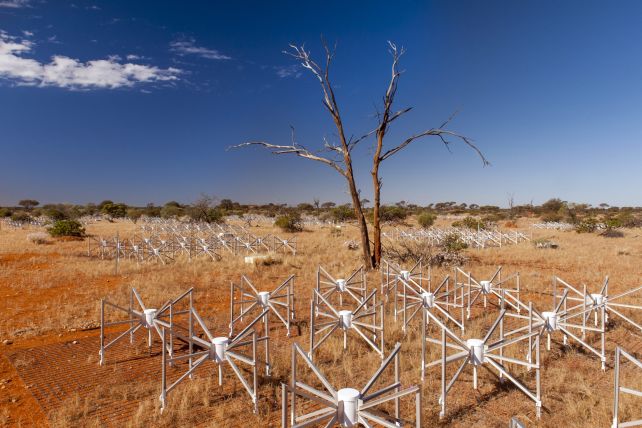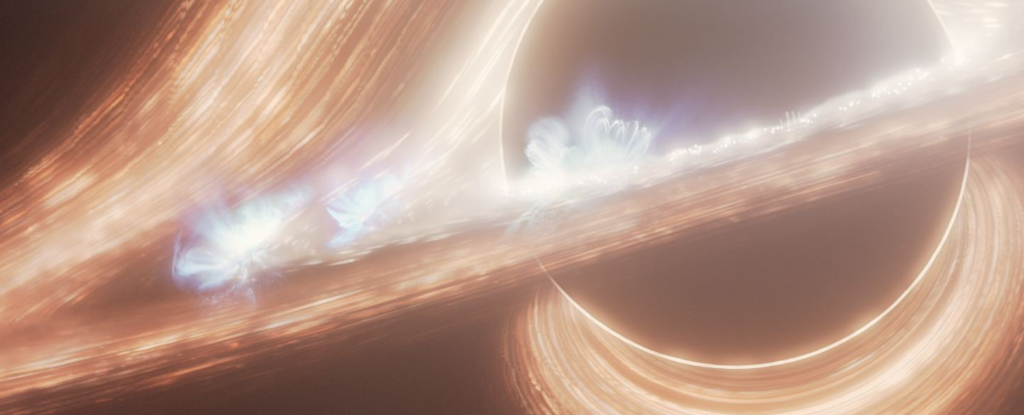ARTICLE AD
Anthropogenic signals are a huge problem in radio astronomy.
In the process of solving a curious mystery, US researchers have now come up with a technique that could better filter our own radio noise from space signals.
We humans are loud in radio waves. We use it for communications, of course, of all kinds; but much of our technology is a source, from electrical appliances and power lines down to the spark gap ignition in gasoline-powered vehicles.
This, occasionally, has led to some interesting problems, the most famous, perhaps, being a microwave oven that created puzzling signals in radio telescope data. Scientists at Brown University in the US recently identified another puzzling signal – and it could lead to improvements in radio astronomy.
The signal itself came from a television. That's not the puzzling part. The puzzling part is that the Murchison Widefield Array that made the detection in the remote Australian desert back in 2013 is in a designated radio quiet zone, a large area locked down tight against anthropogenic radio interference.
Nothing that can leak radio waves is allowed in that area. The facilities are all housed in a Faraday cage building. Any cars driving into the zone need to run on diesel engines. Yet here was a television broadcast signal, streaking across the sky, as bold as you please.
frameborder="0″ allow="accelerometer; autoplay; clipboard-write; encrypted-media; gyroscope; picture-in-picture; web-share" referrerpolicy="strict-origin-when-cross-origin" allowfullscreen>
"It then hit us," says physicist Jonathan Pober of Brown University. "We said, 'I bet the signal is reflecting off an airplane.' We'd been seeing these signals for close to five years, and several people had suggested they were airplanes reflecting television broadcasts. We realized we might actually be able to confirm this theory for once."
Radio frequency interference, in our increasingly technological world, is becoming harder to avoid in radio astronomy. One of the biggest potential problems is the sheer volume of satellites being launched in constellations that number in the thousands. Research has shown that some of these satellites are leaking radio waves in the range reserved for astronomy.
Terrestrial radio quiet zones can shield instruments from interference generated on the ground; but currently, there's no way to block out signals from overhead.
"Astronomy is facing an existential crisis," Pober explains. "There is growing concern – and even some reports – that astronomers may soon be unable to carry out high-quality radio observations, as we know it, due to interference from satellite constellations. This is particularly challenging for telescopes like the Murchison Widefield Array, which observes the entire sky simultaneously. There's no way to point our telescopes away from satellites."
 The Murchison Widefield Array consists of 4,096 radio antennas arrayed across Australia's Pilbara desert. (Marianne Annereau/MWA Telescope)
The Murchison Widefield Array consists of 4,096 radio antennas arrayed across Australia's Pilbara desert. (Marianne Annereau/MWA Telescope)Previously, any data polluted by anthropogenic radio interference was simply discarded, since it was too hard to isolate and extract the contaminating signal. But going into the future, that solution is untenable.
Pober and his colleague, physicist Jade Ducharme of Brown University, thought that if they could find a way to isolate the television signal reflecting off a passing airplane, they might be able to develop a way to track interference signals – the tool required to extract them and reclaim usable radio astronomy data.
To characterize the signal detected by the Murchison Widefield Array, the researchers used multiple methods to refine the data. The first was a technique called near-field corrections, which applies a stronger focus to nearby objects, as opposed to the deep-space observations normally made by radio telescopes.
The second is beamforming, a technique that sharpens the curved near-field signals received by the Murchison Widefield Array.
Together, these techniques allowed the researchers to identify the source of the signal as an airplane cruising by at an altitude of 11.7 kilometers (38,400 feet) and a speed of 792 kilometers (492 miles) per hour. They even narrowed down the source of the broadcast – the frequency was one associated with a digital TV channel used by Australia's Seven Network.
They were unable to identify the aircraft responsible, however, because publicly available flight logs didn't extend back to 2013. But the conclusions the team was able to draw shows that it is possible to extract radio interference from data, thus preserving what could be scientifically valuable observations that would otherwise be scrapped.
"This is a key step toward making it possible to subtract human-made interference from the data," Pober says. "By accurately identifying and removing only the sources of interference, astronomers can preserve more of their observations, reduce frustrating data loss and increase the chances of making important discoveries."
Only time will tell how severe the problem will grow in the years to come. But the work of Ducharme and Pober suggests that there may be a way forward for terrestrial radio astronomy, at least for a little while longer.
The research has been published in the Publications of the Astronomical Society of Australia.

 14 hours ago
14
14 hours ago
14 

